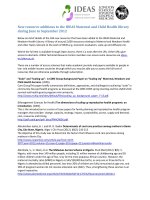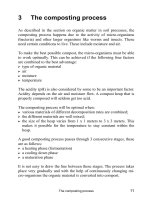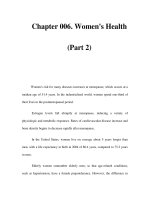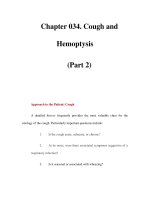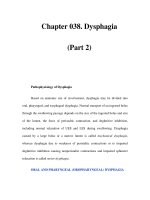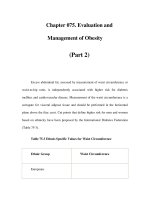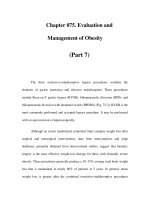Chapter 140. Infections Due to the HACEK Group and Miscellaneous Gram-Negative Bacteria (Part 2) ppsx
Bạn đang xem bản rút gọn của tài liệu. Xem và tải ngay bản đầy đủ của tài liệu tại đây (42.88 KB, 5 trang )
Chapter 140. Infections Due to the HACEK Group
and Miscellaneous Gram-Negative Bacteria
(Part 2)
Kingella kingae
Because of improved microbiologic methodology, isolation of K. kingae is
increasingly common. Inoculation of clinical specimens (e.g., synovial fluid) into
aerobic blood culture bottles enhances recovery of this organism. In recent series,
K. kingae has been the third most common cause of septic arthritis in children <24
months of age; staphylococcal and streptococcal species remain most prevalent.
Invasive K. kingae infections with bacteremia are associated with upper
respiratory tract infections and stomatitis. Both K. kingae colonization and primary
herpes—a major cause of stomatitis—peak in children 6–48 months of age. K.
kingae bacteremia can present with a petechial rash similar to that seen in
Neisseria meningitidis sepsis.
Infective endocarditis, unlike other infections with K. kingae, occurs in
older children and adults. The majority of patients have preexisting valvular
disease. There is a high incidence of complications, including arterial emboli,
cerebrovascular accidents, tricuspid insufficiency, and congestive heart failure
with cardiovascular collapse.
Endocarditis Caused by HACEK Organisms: Treatment
See Table 140-1. Native-valve endocarditis should be treated for 4 weeks
with antibiotics, whereas prosthetic-valve endocarditis requires 6 weeks of
therapy. The cure rates for HACEK prosthetic-valve endocarditis appear to be
high. Unlike prosthetic-valve endocarditis caused by other gram-negative
organisms, HACEK endocarditis is often cured with antibiotic treatment alone—
i.e., without surgical intervention.
Table 140-
1 Treatment of Endocarditis Caused by HACEK Group
Organisms
a
Organism Initial
Therapy
Alternative Agents
Commen
ts
Haemophilus
species,
Actinobacillus
actinomycetemcomita
Ceftriaxo
ne (2 g/d)
Ampicillin/sulbact
am (3 g of ampicillin
q6h) or
fluoroquinolones
b
Ampicill
in ± an
aminoglycoside
can be used if
ns
the organism
does not
produce β-
lactamase.
c
Cardiobacteriu
m hominis
Penicillin
(16–
18 mU/d in
6 divided doses)
or ampicillin (2
g q4h)
Ceftriaxone (2
g/d)
or
ampicillin/sulbactam (3 g
of ampicillin q6h)
An
aminoglycoside
(gentamicin, 3
mg/kg per day
in 3 divided
doses) may be
added, but its
value has not
been proven.
The organism is
usually
pansensitive,
but high-
level
penicillin
resistance has
been reported.
Eikenella
corrodens
Ampicilli
n (2 g q4h)
Ceftri
axone (2
g/d) or fluoroquinolones
b
The
organism is
typically
resistant to
clindamycin,
metronidazole,
and
aminoglycoside
s.
Kingella
kingae
Ceftriaxo
ne (2 g/d) or
ampicillin (3 g
q6h)
Fluoroquinolones
b
The
prevalence of
β-lactamase-
producing
strains is
increasing.
Efficacy for
invasive
infections is
best
demonstrated
for first-
line
treatments.
a
Susceptibility testing should be performed in all cases to guide therapy.
b
Fluoroquinolones are not recommen
ded for treatment of children <17
years of age.
c
European guidelines for endocarditis recommend the addition of
gentamicin (3 mg/kg per day in 3 divided doses for 2–4 weeks).
